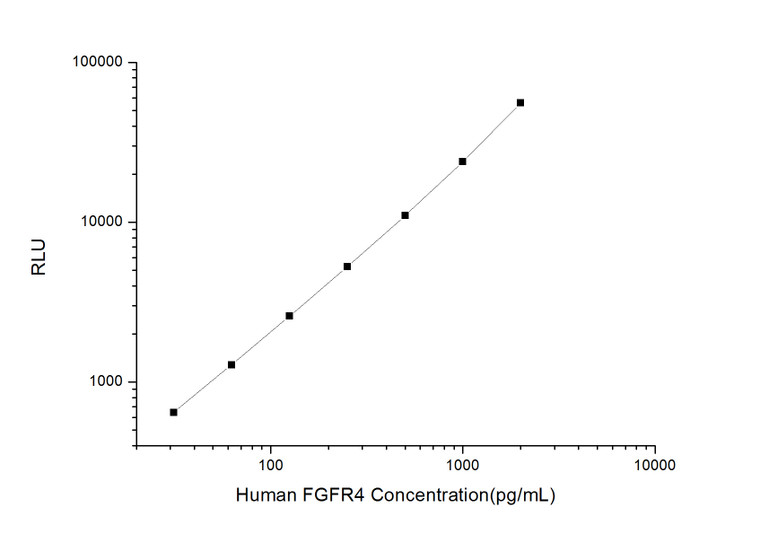| Applications: |
CLIA |
| Reactivity: |
Human |
| Note: |
FOR SCIENTIFIC EDUCATIONAL RESEARCH USE ONLY (RUO). MUST NOT BE USED IN DIAGNOSTIC OR OTHER MEDICAL APPLICATIONS. |
| Sensitivity: |
18.75pg/mL |
| Detection Limit: |
31.25~2000pg/mL |
| Short Description: |
This human FGFR4 kit is a highly sensitive in-vitro chemiluminescent immunoassay for the measurement of trace amounts of analytes. |
| Storage Instruction: |
If unopened the kit may be stored at 2-8°C for up to 1 month. If the kit will not be used within 1 month, store the components separately, according to the component table in the manual. |
| Assay Time: |
3.5h |
| Detection: |
Chemiluminescence |
| Gene Symbol: |
FGFR4 |
| Gene ID: |
2264 |
| Uniprot ID: |
FGFR4_HUMAN |
| Specificity: |
This kit recognizes Human FGFR4 in samples. No significant cross-reactivity or interference between Human FGFR4 and analogues was observed. |
| Sample Type: |
Serum, plasma and other biological fluids |
| Tissue Specificity | Expressed in gastrointestinal epithelial cells, pancreas, and gastric and pancreatic cancer cell lines. |
| Post Translational Modifications | N-glycosylated. Full maturation of the glycan chains in the Golgi is essential for high affinity interaction with FGF19. Ubiquitinated. Subject to proteasomal degradation when not fully glycosylated. Autophosphorylated. Binding of FGF family members together with heparan sulfate proteoglycan or heparin promotes receptor dimerization and autophosphorylation on tyrosine residues. Autophosphorylation occurs in trans between the two FGFR molecules present in the dimer. |
| Function | Tyrosine-protein kinase that acts as cell-surface receptor for fibroblast growth factors and plays a role in the regulation of cell proliferation, differentiation and migration, and in regulation of lipid metabolism, bile acid biosynthesis, glucose uptake, vitamin D metabolism and phosphate homeostasis. Required for normal down-regulation of the expression of CYP7A1, the rate-limiting enzyme in bile acid synthesis, in response to FGF19. Phosphorylates PLCG1 and FRS2. Ligand binding leads to the activation of several signaling cascades. Activation of PLCG1 leads to the production of the cellular signaling molecules diacylglycerol and inositol 1,4,5-trisphosphate. Phosphorylation of FRS2 triggers recruitment of GRB2, GAB1, PIK3R1 and SOS1, and mediates activation of RAS, MAPK1/ERK2, MAPK3/ERK1 and the MAP kinase signaling pathway, as well as of the AKT1 signaling pathway. Promotes SRC-dependent phosphorylation of the matrix protease MMP14 and its lysosomal degradation. FGFR4 signaling is down-regulated by receptor internalization and degradation.MMP14 promotes internalization and degradation of FGFR4. Mutations that lead to constitutive kinase activation or impair normal FGFR4 inactivation lead to aberrant signaling. |
| Protein Name | Fibroblast Growth Factor Receptor 4Fgfr-4Cd Antigen Cd334 |
| Database Links | Reactome: R-HSA-109704Reactome: R-HSA-1257604Reactome: R-HSA-1307965Reactome: R-HSA-1839128Reactome: R-HSA-190322Reactome: R-HSA-2219530Reactome: R-HSA-5654228Reactome: R-HSA-5654712Reactome: R-HSA-5654719Reactome: R-HSA-5654720Reactome: R-HSA-5654733Reactome: R-HSA-5655291Reactome: R-HSA-5673001Reactome: R-HSA-6811558 |
| Cellular Localisation | Cell MembraneSingle-Pass Type I Membrane ProteinEndosomeEndoplasmic ReticulumInternalized From The Cell Membrane To Recycling EndosomesAnd From There Back To The Cell MembraneIsoform 2: Secreted |
| Alternative CLIA Names | Fibroblast Growth Factor Receptor 4 CLIA kitFgfr-4 CLIA kitCd Antigen Cd334 CLIA kitFGFR4 CLIA kitJTK2 CLIA kitTKF CLIA kit |
| Specificity | This kit recognizes Human FGFR4 in samples. No significant cross-reactivity or interference between Human FGFR4 and analogues was observed. |
| Reproducibility | Both intra-CV and inter-CV are |
Information sourced from Uniprot.org
| Item | Specifications | Storage |
| Micro CLIA Plate (Dismountable) | 96T: 8 wells ×12 strips strips | -20℃, 6 months |
| Reference Standard | 96T: 2 vials 48T: 1 vial | -20℃, 6 months |
| Concentrated Biotinylated Detection Ab (100×) | 96T: 1 vial, 120 μL 60 μL | -20℃, 6 months |
| Concentrated HRP Conjugate (100×) | 96T: 1 vial, 120 μL 60 μL | -20℃ (Protect from light), 6 months |
| Reference Standard & Sample Diluent | 1 vial, 20 mL | 2-8°C, 6 months |
| Biotinylated Detection Ab Diluent | 1 vial, 14 mL | 2-8°C, 6 months |
| HRP Conjugate Diluent | 1 vial, 14 mL | 2-8°C, 6 months |
| Concentrated Wash Buffer (25×) | 1 vial, 30 mL | 2-8°C, 6 months |
| Substrate Reagent A | 1 vial, 5 mL | 2-8℃ (Protect from light) |
| Substrate Reagent B | 1 vial, 5 mL | 2-8℃ (Protect from light) |
| Plate Sealer | 5 pieces | |
| Manual | 1 copy | |
| Certificate of Analysis | 1 copy | |
| Sample Type | Range (%) | Average Recovery (%) |
| Serum(n=8) | 90-106 | 97 |
| EDTA plasma(n=8) | 95-109 | 103 |
| Cell culture media(n=8) | 83-98 | 90 |
| | Intra-assay Precision | Intra-assay Precision | Intra-assay Precision | Inter-assay Precision | Inter-assay Precision | Inter-assay Precision |
| Sample | 1.00 | 2.00 | 3.00 | 1.00 | 2.00 | 3.00 |
| n | 20.00 | 20.00 | 20.00 | 20.00 | 20.00 | 20.00 |
| Mean (pg/mL) | 96.50 | 310.09 | 682.92 | 104.11 | 299.51 | 627.13 |
| Standard deviation | 10.89 | 28.22 | 54.43 | 9.09 | 27.32 | 46.72 |
| CV (%) | 11.28 | 9.10 | 7.97 | 8.73 | 9.12 | 7.45 |
12 months for antibodies. 6 months for ELISA Kits. Please see website T&Cs for further guidance







